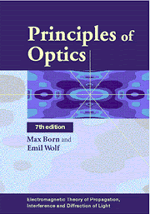Book contents
- Frontmatter
- Preface to corrected reprint of the seventh edition
- Preface to the first edition
- Preface to the second edition
- Preface to the third edition
- Preface to the fourth edition
- Preface to the fifth edition
- Preface to the sixth edition
- Preface to the seventh edition
- Contents
- Historical introduction
- I Basic properties of the electromagnetic field
- II Electromagnetic potentials and polarization
- III Foundations of geometrical optics
- IV Geometrical theory of optical imaging
- V Geometrical theory of aberrations
- VI Image-forming instruments
- VII Elements of the theory of interference and interferometers
- VIII Elements of the theory of diffraction
- IX The diffraction theory of aberrations
- X Interference and diffraction with partially coherent light
- XI Rigorous diffraction theory
- XII Diffraction of light by ultrasonic waves
- XIII Scattering from inhomogeneous media
- XIV Optics of metals
- XV Optics of crystals
- Appendices
- Author index
- Subject index
VIII - Elements of the theory of diffraction
- Frontmatter
- Preface to corrected reprint of the seventh edition
- Preface to the first edition
- Preface to the second edition
- Preface to the third edition
- Preface to the fourth edition
- Preface to the fifth edition
- Preface to the sixth edition
- Preface to the seventh edition
- Contents
- Historical introduction
- I Basic properties of the electromagnetic field
- II Electromagnetic potentials and polarization
- III Foundations of geometrical optics
- IV Geometrical theory of optical imaging
- V Geometrical theory of aberrations
- VI Image-forming instruments
- VII Elements of the theory of interference and interferometers
- VIII Elements of the theory of diffraction
- IX The diffraction theory of aberrations
- X Interference and diffraction with partially coherent light
- XI Rigorous diffraction theory
- XII Diffraction of light by ultrasonic waves
- XIII Scattering from inhomogeneous media
- XIV Optics of metals
- XV Optics of crystals
- Appendices
- Author index
- Subject index
Summary
Introduction
IN carrying out the transition from the general electromagnetic field to the optical field, which is characterized by very high frequencies (short wavelengths), we found that in certain regions the simple geometrical model of energy propagation was inadequate. In particular, we saw that deviations from this model must be expected in the immediate neighbourhood of the boundaries of shadows and in regions where a large number of rays meet. These deviations are manifested by the appearance of dark and bright bands, the diffraction fringes. Diffraction theory is mainly concerned with the field in these special regions; such regions are of great practical interest as they include the part of the image space in which the optical image is situated (region of focus).
The first reference to diffraction phenomena appears in the work of Leonardo da Vinci (1452–1519). Such phenomena were, however, first accurately described by Grimaldi in a book, published in 1665, two years after his death. The corpuscular theory, which, at the time, was widely believed to describe correctly the propagation of light, could not explain diffraction. Huygens, the first proponent of the wave theory, seems to have been unaware of Grimaldi's discoveries; otherwise he would have undoubtedly quoted them in support of his views. The possibility of explaining diffraction effects on the basis of a wave theory was not noticed until about 1818. In that year there appeared the celebrated memoir of Fresnel (see Historical introduction) in which he showed that diffraction can be explained by the application of Huygens’ construction (see §3.3.3) together with the principle of interference. Fresnel's analysis was later put on a sound mathematical basis by Kirchhoff (1882), and the subject has since then been extensively discussed by many writers.
- Type
- Chapter
- Information
- Principles of OpticsElectromagnetic Theory of Propagation, Interference and Diffraction of Light, pp. 412 - 516Publisher: Cambridge University PressPrint publication year: 1999
- 22
- Cited by

